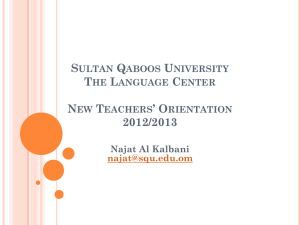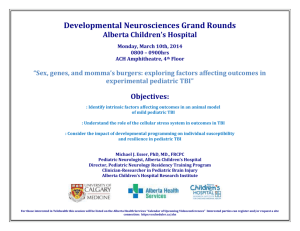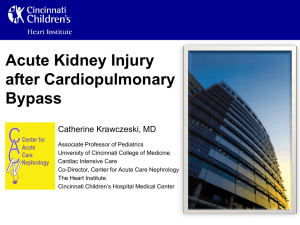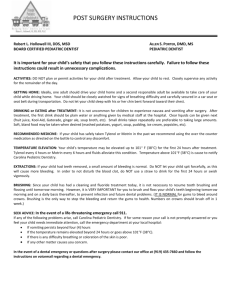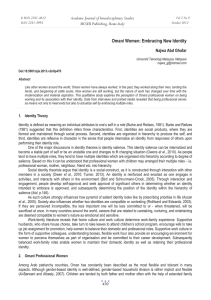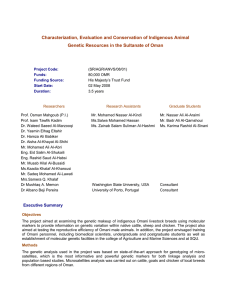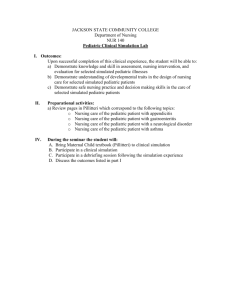handouts for residentsfinal
advertisement
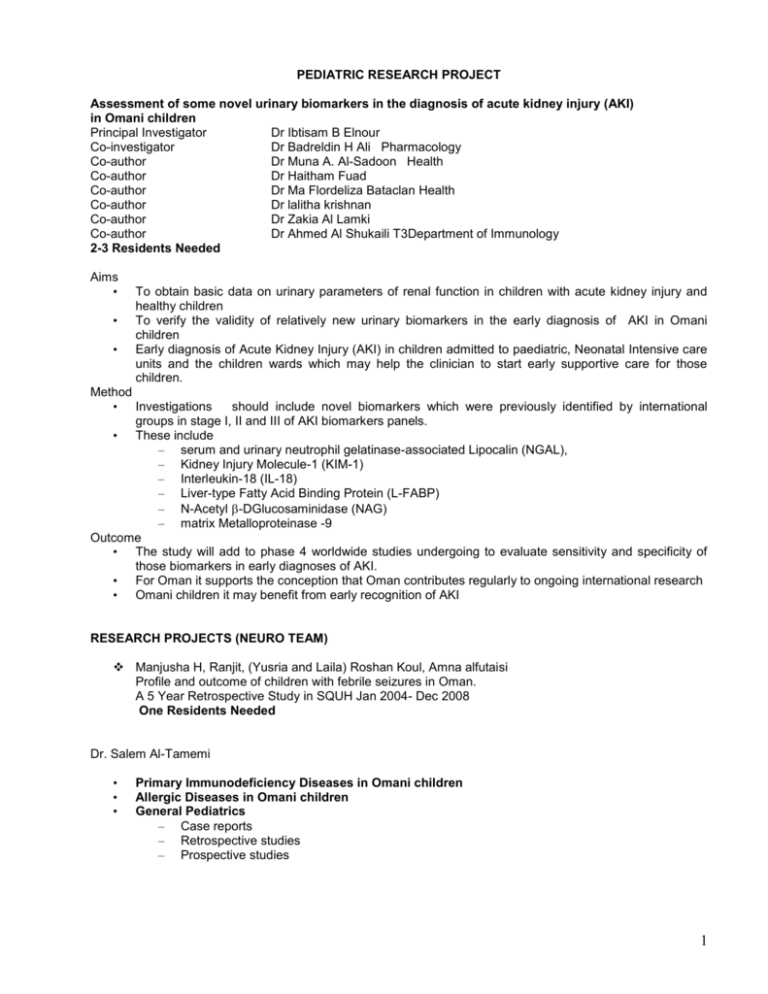
PEDIATRIC RESEARCH PROJECT Assessment of some novel urinary biomarkers in the diagnosis of acute kidney injury (AKI) in Omani children Principal Investigator Dr Ibtisam B Elnour Co-investigator Dr Badreldin H Ali Pharmacology Co-author Dr Muna A. Al-Sadoon Health Co-author Dr Haitham Fuad Co-author Dr Ma Flordeliza Bataclan Health Co-author Dr lalitha krishnan Co-author Dr Zakia Al Lamki Co-author Dr Ahmed Al Shukaili T3Department of Immunology 2-3 Residents Needed Aims • • • To obtain basic data on urinary parameters of renal function in children with acute kidney injury and healthy children To verify the validity of relatively new urinary biomarkers in the early diagnosis of AKI in Omani children Early diagnosis of Acute Kidney Injury (AKI) in children admitted to paediatric, Neonatal Intensive care units and the children wards which may help the clinician to start early supportive care for those children. Method • Investigations should include novel biomarkers which were previously identified by international groups in stage I, II and III of AKI biomarkers panels. • These include – serum and urinary neutrophil gelatinase-associated Lipocalin (NGAL), – Kidney Injury Molecule-1 (KIM-1) – Interleukin-18 (IL-18) – Liver-type Fatty Acid Binding Protein (L-FABP) – N-Acetyl -DGlucosaminidase (NAG) – matrix Metalloproteinase -9 Outcome • The study will add to phase 4 worldwide studies undergoing to evaluate sensitivity and specificity of those biomarkers in early diagnoses of AKI. • For Oman it supports the conception that Oman contributes regularly to ongoing international research • Omani children it may benefit from early recognition of AKI RESEARCH PROJECTS (NEURO TEAM) Manjusha H, Ranjit, (Yusria and Laila) Roshan Koul, Amna alfutaisi Profile and outcome of children with febrile seizures in Oman. A 5 Year Retrospective Study in SQUH Jan 2004- Dec 2008 One Residents Needed Dr. Salem Al-Tamemi • • • Primary Immunodeficiency Diseases in Omani children Allergic Diseases in Omani children General Pediatrics – Case reports – Retrospective studies – Prospective studies 1 ROP in VLBW Dr. Lalitha Krishnan NNL SQUH 10 year data study All inborn babies less than 32 wks/1500g Incidence, risk factors, severity and outcome Study of trend over a decade The late preterm Babies from 33-36 weeks 3 year data Type of delivery, morbidity and mortality Re-admissions in the first year Outcome of VLBW 5 year data study Inborn babies below 1500g/32 weeks Morbidity and mortality Antenatal steroids and RDS 3 year data study All babies below 34 weeks Antenatal steroids and RDS incidence, severity, surfactant use, chronic lung disease and mortality Clinical features of juvenile idiopathic arthritis in Omani pediatric population Dr. Safiya Al Abrawi, Dr. Reem Abdwani 2 Residents Needed Background: Juvenile idiopathic arthritis is the most common rheumatic disease of children which begins before 16 years of age. It is also one of the more frequent chronic illnesses of childhood causes long-term disabilities. Objectives: To determine the clinical features and outcome of Juvenile Idiopathic Arthritis (JIA) in Omani children (Royal Hospital and SQUH) This is the first review of juvenile idiopathic arthritis in Omani paediatric population. Pediatric Bacteremia (SQUH experience) Dr. Reem Abdwani, Dr. Mahmood, Dr. Renjit Residents needed: One Resident Aims and objectives: • To identify the rate of false positive blood cultures drawn from pediatric patients (A&E, Wards, OPD). • To identify the rate of true bacteremia and clinical outcome in pediatric patients. • To determine the role of inflammatory markers in true bacteremia • To identify the most common organisms causing bacteremia in children • To determine the antibiotic sensitivity patterns. Methods • Retrospective study • Electronic databases were searched for positive blood cultures in paediatric patients(Total no. 413) presented to A & E,OPD and in the wards. • The study included paediatric patients in the age between day 1 and 13 years. • Datas collected from the patients presented during the last 2 years(2006 -2008) 2 Department of Child Health and Inborn Errors of Metabolism Dr S N Joshi List of Ongoing research projects: 1. Newborn screening for IEM and other diseases for all babies born at SQU Hospital. Dr Lalitha Krishnan, Dr S N Joshi, Dr Saif al-Yaarubi, Dept of child Health, SQUH, Prof Riad Bayoumi, Matar al-Mani, Dept. of Biochemistry, SQUH. 2. Research study on “Effects of sodium valproate treatment on free carnitine levels in pediatric epileptic patients and justification of routine carnitine supplementation” in collaboration with Pediatric Neurology and department of Biochemistry. Dr R. Koul, Dr S N Joshi Dept. of Child Health ,Mr. Matar Al Maani, Dept. of Biochemistry. One Resident Needed 3. Clinical trial on long-term effects of NTBC compound in treatment of five patients with Hepato-Renal Tyrosinemia (TYROSINEMIA-1). In collaboration with Orphan Pharmaceuticals, Sweden. The trial is now in its 8 th Year with excellent therapeutic results. Principal Investigator; Dr S N Joshi, Dept of Child Health and IEM. One Resident in each 4. International collaboration trial on Enzyme replacement therapy (ERT) in Gaucher Disease. The trial is conducted under guidance and supervision of Genzyme General Corporation, Cambridge, USA. Principal Investigator: Dr S N Joshi, Dept of Child Health and IEM. 5. High risk screening for Inborn errors of metabolism by Tandem Mass Spectrometery in Oman: The project involves all newborn babies and children referred to SQU Hospital with clinical or biochemical features suggestive of IEM. The study aims to define the cost effectiveness of this approach to Mass screening in identifying new cases. Dr S N Joshi. One Resident needed Clinical pattern, Management and Outcome of Hyperbilirubinemia due to Blood group incompatability in term newborn babies: A Royal Hospital Experience Dr. M.G.Pai Dr. Bashir Ahmad Itoo SCBU Royal Hospital Routine blood tests in well and growing preterm infants Dr. Mujtaba Ali Al-Ajmi Dr. Prakash Manikoth SCBU Royal Hospital A retrospective study to analyze the results of routine blood tests; CBC, Retics, LFT, U/E and Bone profile performed on 100 growing preterm infants in SCBU for: 1. Any abnormal values. 2. Nature and frequency of resulting intervention. 3 Research Projects Dr Khoula Al-Said Pediatric Gastroenterology Achalasia Cardia in Oman • Introduction: – Achalasia Cardia is uncommon entity in children – Familial cases are rare – Treatment is variable • Proposal: – Retrospective chart review of pediatrics achalasia Cardia – Review of the literature Conjugated hyperbilirubinemia • Introduction: – Conjugated hyperbilirubinemia is a common presentation in infants presenting to Pediatrician – in many cases. The hyperbilirubinemia usually resolve – In Oman, genetic/metabolic disorders are the most common • Proposal: – Retrospective chart review of cases of conjugated hyperbilirubinemia • Review of patient characteristics and identifying those who have a genetic/metabolic disorder. Case Reports • Hepatocellular carcinoma in a child with chronic hepatitis B • Neonatal onset IBD Research Topics from PICU Dr Said Al Hanshi Dr Mohammed Al Ghafri Extubation Failure in PICU • Extubation failure is a problem encountered in both adult and pediatric ICUs. • Prospective observational study • Primary outcome measures:- Extubation failure rate • Secondary outcome measures:- Type of patients prone for failed extubation - Causes of extubation failure Incidence of Junctional Ectopic Tachycardia (JET) in the PCICU • JET is a well known complication after open heart surgery in children • Prospective observational study • Primary outcome: - Incidence of JET after open heart surgery • Secondary outcome: - Lesions commonly associated with JET - The need for anti-arrhythmic treatment Use of PRISM Score as a predictor of mortality in the PICU • PRISM score is one of the tools used to predict mortality in PICU • Prospective observational study • Outcome measure: 4 - Evaluate the observed mortality in the PICU with the predicted mortality estimated by PRISM score National study of Nephrotic syndrome in Oman, Epidemiology and response to treatment 2006-2010 Principle Investigators: Dr Ibtisam B Elnour, SQUH Dr Dana Al Nabhani, SQUH Co-author: Dr Mohammed Al Ryami Dr Laikha, RH Introduction • Nephrotic syndrome is a common renal disorder of childhood. Typical presentation of idiopathic type is known to have a good prognosis. Prognostic features include age at presentation, absence of hypertension and macroscopic haematuria, normal renal function and normal serum complement levels. • 85% of children with INS respond to steroid therapy. Most of the cases of childhood Nephrotic syndrome are treated by general paediatrician at regional hospitals, only those with recurrent relapses are referred to the tertiary hospitals. Different paediatrician may give different protocols. • Epidemiological factors have not been studied in Oman, neither patient’s response to treatment. Aim This is a 5 years multi centered study aimed to. 1. Establish the epidemiological factors among Omani children with Nephrotic syndrome 2. Recognize the different protocols given by different paediatrician at regional hospitals. 3. Evaluate and compare the response to treatment of the different protocols 4. Determine the incidence of steroid resistant Nephrotic syndrome. 5. Analyze the outcome of the study and outline future recommendations. Method • Patients’ data will be collected from the medical file/EPR system, January 2006-2010 years. Residents undergoing training by OMSB will be selected. Data from each regional hospital will be allocated for one resident. • Data has to be analyzed statistically to compare the out come in different hospital and response to treatment • 6 Residents could be included in the study 5

